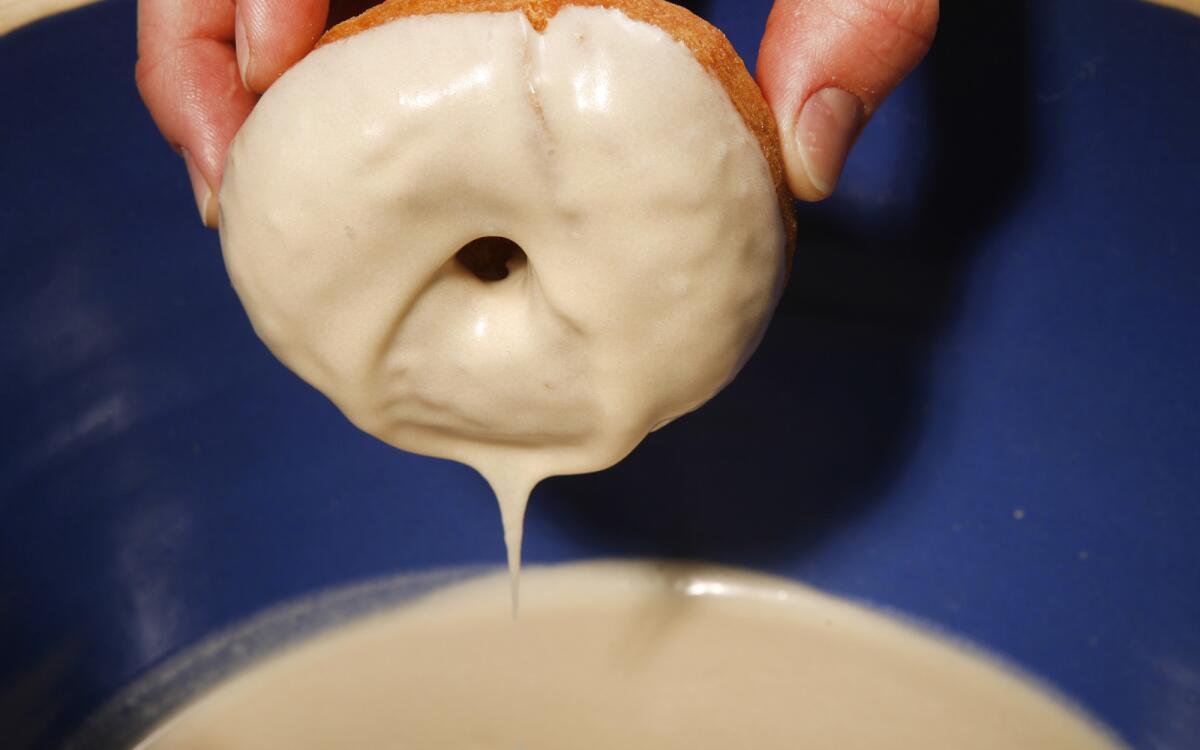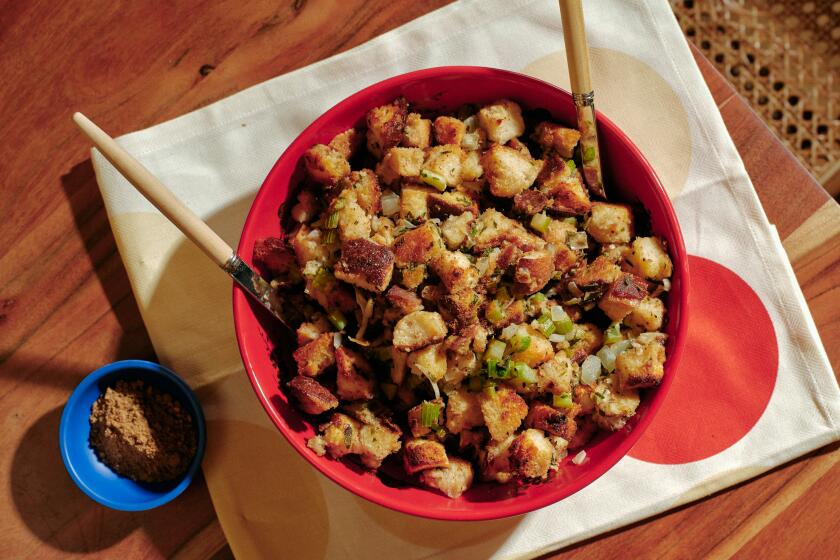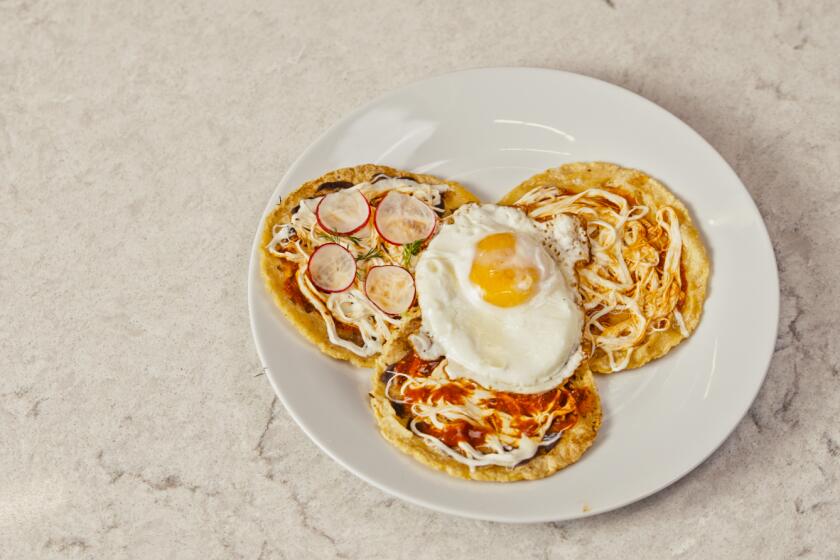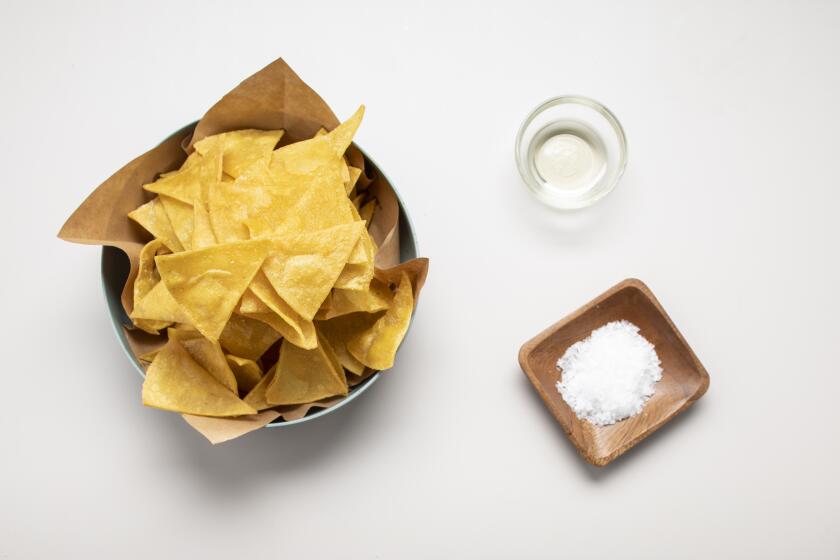Buttermilk doughnuts

- Share via
My favorite mornings growing up, I’d wake to the sounds of Mom busy in the kitchen, rolling out freshly risen dough as a pot of oil heated on the stove. I could soon tell by the aromas wafting through the house that the morning was going to be special.
Mom was making doughnuts for breakfast.
Before too long, we were picking out our favorites from the freshly frosted bunch. I always chose one of the long johns she shaped using a large dog-bone-shaped cookie cutter. My siblings and I would pile in front of the TV, all four of us propped against the family dog (a very big St. Bernard), devouring her creations as we fought for the remote.
The crisp, brittle crust of each golden-brown doughnut would give way to a warm and tender interior, delicately flavored and comfortingly fragrant. We’d savor every last bite, licking the rich chocolate glaze from our fingers as we watched cartoons.
There’s something magical about the doughnut. You don’t have to be Homer Simpson to swoon when you’re greeted with all those bright colors and sparkly decorations in a doughnut shop display case. But no matter how wonderful they may appear, it’s hard to find a store-bought doughnut that compares with homemade.
And believe it or not, they’re really not hard to make. You can whip up a batch of cake doughnuts in about an hour. Put together a batch of yeast-raised the night before, and all you have to do is fry them the next morning. Making breakfast for someone special? Try a batch of French crullers, their thin, golden crusts yielding to the most delicate, lightly flavored interiors.
Basic varieties
A classic buttermilk cake doughnut is a great place to begin. The method is similar to a classic cake recipe but with a slightly thicker dough. I add an extra egg yolk for a little more richness, and mix in a cup of buttermilk for both texture and a hint of tang.
Leavened with baking powder and a little baking soda, these doughnuts don’t need time to rise. Simply roll them out and cut them up. Use a doughnut cutter, or go with a couple of biscuit cutters or empty cans.
Then fry. Use a neutral, refined oil, such as canola or vegetable oil -- they have a higher smoking point and a more neutral flavor. And always use a thermometer -- a candy or digital probe works well -- to keep the temperature consistent.
Proper temperature is key: too high and the doughnut’s crust will scorch before it is done in the center; too low and the doughnut won’t cook in the oil, it will soak it up like a sponge.
For chocolate lovers, there’s nothing like a great devil’s food doughnut, but so many times the store-bought variety is overly sweet and artificial tasting.
These are made with a technique similar to the buttermilk cake doughnuts. The trick here is adding a good amount of chocolate to the recipe -- I use both melted chocolate and cocoa for depth of flavor. Splurge a little and buy good chocolate; you’ll taste the difference. And add some coffee -- you won’t taste it but it will help bring out the chocolate flavor.
Finally, fold in a little sour cream: It lends a slight tang and lightens the structure of the cake, making for a more delicate crumb.
Then, of course, there are yeast-raised doughnuts. The best are wonderfully light and fluffy. Not quite Krispy Kreme light -- you want to know you’re eating one -- and with just a little “chew” to give it personality. The key is a very moist dough.
These take a little more time to prepare. You need to mix the dough and give it time to rise before rolling out and cutting. But a little investment in advance preparation yields a nice payoff, as most of the work can be done the day before you fry.
Refrigerate the raw doughnuts overnight, then set them out on the counter first thing in the morning to warm and begin rising while you inhale that first cup of super-strong coffee. Then all you have to do is fry the doughnuts and frost them.
French airs
And what about French crullers? Wreath-shaped puffs of air that are piped before baking, crullers may at first seem intimidating, but they’re nowhere near as difficult as they may appear, once you figure them out. And the flavor is terrific.
Unlike cake doughnuts that use chemical leaveners, or risen doughnuts that rely on yeast, French crullers are based on pate `a choux, the same dough used to make cream puffs and eclairs. The trick is making a doughnut that is light and airy but still firm enough so it won’t collapse as it cools -- something both delicate and structured.
After a lot of trial and error (and several dozen eggs), I found a winner. For help, I turned to Rose Levy Beranbaum’s chapter on cream puff pastry in “The Pie and Pastry Bible.” She adds additional egg whites to increase the structure and crispness and stresses using water instead of milk in the base (milk causes the egg to bind more quickly when cooked, reducing potential volume).
But perhaps the best trick she gave was making the dough in the food processor -- it’s much easier than mixing in the eggs by hand and it increased the volume of my crullers by a third. From now on, I’ll never make choux paste any other way.
Another problem I had was getting the delicate cruller dough into the oil to fry. I found the solution in Nancy Silverton’s excellent “Pastries From the La Brea Bakery,” in which she suggests piping the dough onto a square of well-greased parchment paper and then flipping the paper and cruller over into the hot oil, allowing the pastry to slide off -- this helps the cruller keep its shape.
When they fry, these puff up nicely for about a minute or so, and then they sort of explode around the edges. This is fine ( choux dough cracks when it bakes in the oven too). Just keep frying them until they’re golden all over. They triple in size.
Because they crack, the doughnuts may be a bit misshapen. I prefer to call them “artisan” or “rustic,” but if you’re really concerned about looks, frosting, like makeup, works wonders on imperfections.
Glazes are simple to make. For the chocolate, simply heat some cream, water, butter and a little vanilla and then stir over a bowl of some chocolate chunks or chips to melt. The glaze is rich with a beautiful sheen, but the method is simple.
For maple, whisk together syrup with some powdered sugar and butter -- brown the butter first just to give the glaze a little depth.
Or go with a fresh fruit glaze: Whisk chopped or pureed berries or stone fruit with powdered sugar and a little vanilla or a liqueur.
Finally, be sure to enjoy the doughnuts while they’re still warm. Put on another pot of coffee and take in the quiet morning.
Or do what I still do, and throw on some cartoons.
In a large bowl, sift together the flour, baking powder, baking soda, salt, grated nutmeg and cinnamon.
In the bowl of a stand mixer, or in a large bowl using a hand mixer, beat together the eggs and egg yolk with the sugar and vanilla until light and fluffy, 2 to 3 minutes.
In a large measuring cup, stir together the buttermilk and butter.
Alternately beat the dry ingredients and buttermilk mixture into the egg mixture, one-third at a time, until all of the ingredients are combined and a dough is formed. It will be soft and sticky.
With floured hands, remove the dough to a floured board and gently roll out until the dough is one-half inch thick. Using a doughnut cutter, or 2 biscuit cutters (a larger one measuring 3 to 3 1/2 inches in diameter, and a smaller one measuring about 1 inch in diameter), cut the dough into doughnuts, spacing the doughnuts as close as possible. Collect the scraps and roll out to form another batch of doughnuts (note that this batch may be a little tougher than the first as the dough has been worked).
Meanwhile, fill a deep fryer with oil, or a large pot to a depth of at least 3 inches, with oil, and heat to a temperature of 350 degrees.
Gently place the doughnuts in the oil, being careful not to crowd. Fry the doughnuts on each side until puffed and golden, about 1 1/2 to 2 minutes on each side.
Drain the donuts on a rack and cool slightly, then frost and decorate as desired.
Get our Cooking newsletter.
Your roundup of inspiring recipes and kitchen tricks.
You may occasionally receive promotional content from the Los Angeles Times.
















